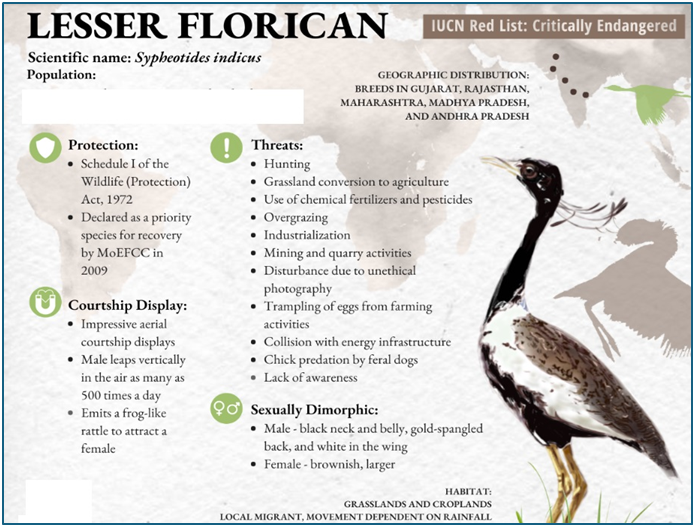Why in news?
The Ministry of Environment, Forest and Climate Change (MoEFCC) has approved Rs 56 crore for the next phase of the conservation of Great Indian Bustard (GIB) and Lesser Florican.
What’s in today’s article?
- Great Indian Bustard (GIB)
- Lesser Florican
- Next phase of conservation plan for Great Indian Bustard
Great Indian Bustard (GIB)
- About
- GIBs are the largest among the four-bustard species found in India.
- The other three being MacQueen’s bustard, lesser florican and the Bengal florican.
- Being terrestrial birds, they spend most of their time on the ground with occasional flights to go from one part of their habitat to the other.
- They feed on insects, lizards, grass seeds etc. GIBs are considered the flagship bird species of grassland and hence barometers of the health of grassland ecosystems.
- Habitat and Status
- This bird, found mainly in Rajasthan and Gujarat, has been categorized as critically endangered by the International Union for Conservation of Nature (IUCN).
- As per the 2021 report of the IUCN, they are on the verge of extinction with hardly 50 to 249 of them alive.
- GIBs’ historic range included much of the Indian sub-continent but it has now shrunken to just 10 per cent of it.
- Among the heaviest birds with flight, GIBs prefer grasslands as their habitats.
- Threats
- Scientists of Wildlife Institute of India (WII) have been pointing out overhead power transmission lines as the biggest threat to the GIBs.
- WII research has concluded that in Rajasthan, 18 GIBs die every year after colliding with overhead powerlines.
- These birds, due to their poor frontal vision, can’t detect powerlines in time and their weight make in-flight quick manoeuvres difficult.
- Kutch and Thar desert are the places which have witnessed creation of huge renewable energy infrastructure over the past two decades.
- This led to installation of windmills and construction of power lines even in core GIB areas.
- Conservation measures
- In 2015, the Central government launched the GIB species recovery programme.
- Under the programme, the WII and Rajasthan Forest department have jointly set up conservation breeding centres where GIB eggs harvested from the wild are incubated artificially and hatchlings raised in controlled environment.
- The plan is to create a population which can act as insurance against the threat of extinction and release the third generation of these captive-bred birds into the wild.
- Bird diverters have also been installed on power lines to protect the Great Indian Bustard (GIB) from collisions.
- The diverters act as reflectors that birds can see from about 50 meters away.
- When birds spot the diverters, they change their flight path to avoid colliding with the power lines.
Lesser Florican
- About
- Lesser florican is the smallest bird of the bustard family (Otididae).
- It is endemic to India and is one of the four bustard species of India.
- Locally, the bird is known as Kharmor (grass peacock) in Gujarat and Khar titar (grass pheasant) in Rajasthan.
- Habitat
- Though it prefers open, grassy landscapes, the lesser florican is generally seen resting within thick bushes during the day.
- In non-breeding months, it can inhabit wooded lands and scrublands, along with grasslands.
- Being omnivorous, their diet ranges from small insects and critters to herbs and shoots.
- It inhabits the states of Rajasthan, Gujarat, Madhya Pradesh, and parts of Andhra Pradesh, Maharashtra, and Karnataka.
- IUCN Status
- The bird is currently listed as Critically Endangered on the IUCN Red List.

Next phase of conservation plan for Great Indian Bustard
- Overview
- Funding Approval - The Ministry of Environment, Forest and Climate Change (MoEFCC) has allocated Rs 56 crore for the next phase of the conservation of the Great Indian Bustard (GIB) and Lesser Florican.
- Conservation Goals - The plan includes habitat development, in-situ conservation, completion of conservation breeding centers, and releasing captive-bred birds.
- Proposal Recommendation - The National CAMPA executive committee recommended the Wildlife Institute of India’s (WII) proposal for scaling up the project for 2024-2033.
- Project Components
- First Component
- Conservation Breeding Centers: Completion of the CBC in Jaisalmer’s Ramdevra and development of the Sorsan Lesser Florican facility.
- Captive-bred Birds: Preparatory work for releasing captive-bred birds and post-release monitoring.
- Artificial Insemination: Development and implementation as a backup for captive breeding.
- Second Component
- In-situ Conservation - Efforts in other range states including Gujarat, Maharashtra, Karnataka, Andhra Pradesh, and Madhya Pradesh.
- Timeline and Activities
- Population Estimation- Between 2024-2026, WII will estimate GIB populations in Jaisalmer and range states, and conduct rangewide population estimation of the Lesser Florican.
- Egg Collection- Annually collect two to four GIB eggs and six to ten Lesser Florican eggs.
- Rewilding- Set to begin in 2027, identifying and developing release sites, and creating soft release enclosures.
- Background
- The conservation programme has been running since 2016 for long-term recovery of critically endangered GIB and Lesser Florican.
- As of now, around 140 GIBs and fewer than 1,000 Lesser Floricans are surviving in the wild.
- Severe decline due to hunting, habitat loss, depredation of eggs, and overhead power lines.
- Current Conservation Facilities
- GIB Breeding Centers: Located in Rajasthan’s Sam and Ramdevra with 40 GIBs.
- Lesser Florican Center: Located in Sorsan with seven individuals.
- Legal Oversight
- Supreme Court Involvement –
- The SC is also monitoring the GIB and Lesser Florican conservation programme.
- A petition seeking protection of the two species is pending before it.
- Power Line Issue –
- SC initially ordered burying power lines in GIB habitats but recalled the order in 2024 due to practicality concerns.
- An expert committee is studying the issue.










